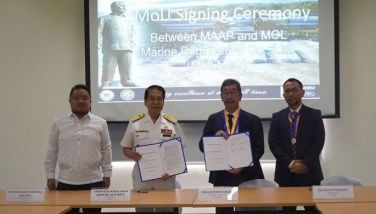Too far or not far enough
November 1, 2005 | 12:00am
It is obvious the Catholic Church in this country is divided, some say hopelessly, on the issue of whether or not President Gloria Macapagal-Arroyo should resign. The Catholic Bishops Conference of the Philippines has famously taken a cautious position and refused to call for GMA’s resignation. The CBCP is sticking to a previously declared stand that the law must govern the resolution of this question.
However, many priests, including heads of religious institutions, Catholic school administrators and individual members of the clergy have taken a radically different path and openly demand her resignation. Priests and nuns are regularly seen in the frontlines of demonstrations which repeatedly defy the GMA government’s No Permit, No Rally rule and test the limits of the Calibrated Preemptive Response policy.
Members of the Church, clergy and laity alike, are clamoring for clear direction, noting that the bishops themselves seem divided on the issue. Catholics are on both sides of the political fence, each arguing the moral superiority of their stand.
On the issue of fighting poverty, for instance, GMA supporters fret that the political crisis must end to allow the government to pursue programs for economic growth which are the key to significantly reducing poverty. On the other hand, the oust-GMA forces argue that current government policy, such as E-VAT, is anti-poor and the GMA administration’s failure in fighting corruption directly results in growing poverty.
The prevailing "confusion," in the Church, it is said, reflects the confusion of the public as a whole. This supposedly explains why "critical mass" or the "tipping point" has not been reached, why the masses are not pouring into the streets despite appeals that the battle is really their battle, why critical sectors such as the military and the business community have not reached consensus on both ends and means.
Everyone says the law must be followed, but somehow the result achieved when the law is observed, i.e. the assumption into office of the Vice-President, strikes many as fundamentally unacceptable. The reasons given, the importuning of the Black and White Movement notwithstanding, run the gamut from doubts about fitness of the Constitutional successor to suspicions of his complicity in electoral fraud.
If there is no single Catholic "line," it is because society at large does not have a unifying line either. The problem with encouraging individual "discernment" is that people wind up not agreeing on anything.
Thus, those who profess that they are convinced GMA "must go" are eloquent when orating about how their hatred for cheating in elections and systematic corruption. But they turn markedly inarticulate when asked to outline alternative policies, and are positively speechless when asked to identify who they think should be the new leader.
Thus too we hear the "Yeah, but who do you replace her with?" lament, and the "Oh, my God! Not him (or her)!" reaction when other personalities are proposed. Idealists might proclaim that it really doesn’t matter, or are reduced to teary-eyed protests of disbelief that 90 million Filipinos can’t produce one good leader. Pragmatists remind us that the realities of running a government do not allow for aimless and endless rumination. In short, name me a name already! Typically, the room empties.
But even if the alternatives are unclear, it cannot mean that we should surrender to the Fates and let events lead us where they will. This is one reason I find the " Guidelines in a Time of Confusion and Crisis," produced a couple of weeks ago by the Jesuit Philippine Province Commission on the Social Apostolate, so helpful.
The Guidelines are not a "to-do" list of projects or actions. Rather, they suggest that this time of confusion and crisis may be better spent in reflection and, yes, discernment of what truly serves our country. It is also clear in the Guidelines’ emphasis on "peaceful and legal means that protect and strengthen our democratic institutions" that extra-constitutional experiments should not be supported.
In this sense, the Guidelines echo the CBCP statement. "(C)are should be taken," the Guidelines stress, " that concrete actions do not support or strengthen groups with covert anti-democratic, adventurist or power-grabbing agenda."
The premises of the Guidelines are familiar: The struggle to bring out the truth must go on because the President has not sufficiently rendered an account to the people and "efforts to hide the facts only confirm the suspicions of many." To dismiss the concern for truth is to condone a culture of impunity: "(O)ur people have become cynical, accepting corruption and deceit as normal in our public life."
At the same time, we must "listen to, reflect seriously on and address the concerns of… people who seem apathetic or whose dissatisfaction does not seem to translate into political action." Our people seem "uninvolved or uninterested" primarily because of "an overriding concern for economic survival during very hard times."
The key words in the courses of action proposed by the Guidelines are conscientization and vigilance. "Conscientization" (I know, a bad word to bashers of a certain kind of NGO) simply means heightened awareness, reasoned commitment and preparation for action. In the Guidelines, conscientization must lead to organizing or reorganizing base groups, forming community and sectoral organizations, and network-building with other sympathetic groups.
Vigilance means mobilization for monitoring government action in the areas of poverty programs, Presidential appointments, apparent retribution against critical sectors, the use and possible abuse of pork barrel, the utilization of funds in the event of a peace agreement in Mindanao, and the preparations (including automation and voter education) for forthcoming electoral exercises.
These proposed actions may seem less dramatic, and to the politicians exploiting the current protests, distinctly lacking in "P.R. or marketing value." But this thoughtful, yet purposeful, approach of the Guidelines is to me far better than the random lashing out that dominates media today. The latter is getting us all nowhere and presents easy, identifiable targets to government for serial elimination.
The calm but deliberate approach suggested by the Guidelines reminds me of what the late Fr. Jim Donelan, S.J., one of my life’s enduring idols, used to refer to as "the quietness of thought around which the whirlwind rides."
However, many priests, including heads of religious institutions, Catholic school administrators and individual members of the clergy have taken a radically different path and openly demand her resignation. Priests and nuns are regularly seen in the frontlines of demonstrations which repeatedly defy the GMA government’s No Permit, No Rally rule and test the limits of the Calibrated Preemptive Response policy.
Members of the Church, clergy and laity alike, are clamoring for clear direction, noting that the bishops themselves seem divided on the issue. Catholics are on both sides of the political fence, each arguing the moral superiority of their stand.
On the issue of fighting poverty, for instance, GMA supporters fret that the political crisis must end to allow the government to pursue programs for economic growth which are the key to significantly reducing poverty. On the other hand, the oust-GMA forces argue that current government policy, such as E-VAT, is anti-poor and the GMA administration’s failure in fighting corruption directly results in growing poverty.
The prevailing "confusion," in the Church, it is said, reflects the confusion of the public as a whole. This supposedly explains why "critical mass" or the "tipping point" has not been reached, why the masses are not pouring into the streets despite appeals that the battle is really their battle, why critical sectors such as the military and the business community have not reached consensus on both ends and means.
Everyone says the law must be followed, but somehow the result achieved when the law is observed, i.e. the assumption into office of the Vice-President, strikes many as fundamentally unacceptable. The reasons given, the importuning of the Black and White Movement notwithstanding, run the gamut from doubts about fitness of the Constitutional successor to suspicions of his complicity in electoral fraud.
If there is no single Catholic "line," it is because society at large does not have a unifying line either. The problem with encouraging individual "discernment" is that people wind up not agreeing on anything.
Thus, those who profess that they are convinced GMA "must go" are eloquent when orating about how their hatred for cheating in elections and systematic corruption. But they turn markedly inarticulate when asked to outline alternative policies, and are positively speechless when asked to identify who they think should be the new leader.
Thus too we hear the "Yeah, but who do you replace her with?" lament, and the "Oh, my God! Not him (or her)!" reaction when other personalities are proposed. Idealists might proclaim that it really doesn’t matter, or are reduced to teary-eyed protests of disbelief that 90 million Filipinos can’t produce one good leader. Pragmatists remind us that the realities of running a government do not allow for aimless and endless rumination. In short, name me a name already! Typically, the room empties.
But even if the alternatives are unclear, it cannot mean that we should surrender to the Fates and let events lead us where they will. This is one reason I find the " Guidelines in a Time of Confusion and Crisis," produced a couple of weeks ago by the Jesuit Philippine Province Commission on the Social Apostolate, so helpful.
The Guidelines are not a "to-do" list of projects or actions. Rather, they suggest that this time of confusion and crisis may be better spent in reflection and, yes, discernment of what truly serves our country. It is also clear in the Guidelines’ emphasis on "peaceful and legal means that protect and strengthen our democratic institutions" that extra-constitutional experiments should not be supported.
In this sense, the Guidelines echo the CBCP statement. "(C)are should be taken," the Guidelines stress, " that concrete actions do not support or strengthen groups with covert anti-democratic, adventurist or power-grabbing agenda."
The premises of the Guidelines are familiar: The struggle to bring out the truth must go on because the President has not sufficiently rendered an account to the people and "efforts to hide the facts only confirm the suspicions of many." To dismiss the concern for truth is to condone a culture of impunity: "(O)ur people have become cynical, accepting corruption and deceit as normal in our public life."
At the same time, we must "listen to, reflect seriously on and address the concerns of… people who seem apathetic or whose dissatisfaction does not seem to translate into political action." Our people seem "uninvolved or uninterested" primarily because of "an overriding concern for economic survival during very hard times."
The key words in the courses of action proposed by the Guidelines are conscientization and vigilance. "Conscientization" (I know, a bad word to bashers of a certain kind of NGO) simply means heightened awareness, reasoned commitment and preparation for action. In the Guidelines, conscientization must lead to organizing or reorganizing base groups, forming community and sectoral organizations, and network-building with other sympathetic groups.
Vigilance means mobilization for monitoring government action in the areas of poverty programs, Presidential appointments, apparent retribution against critical sectors, the use and possible abuse of pork barrel, the utilization of funds in the event of a peace agreement in Mindanao, and the preparations (including automation and voter education) for forthcoming electoral exercises.
These proposed actions may seem less dramatic, and to the politicians exploiting the current protests, distinctly lacking in "P.R. or marketing value." But this thoughtful, yet purposeful, approach of the Guidelines is to me far better than the random lashing out that dominates media today. The latter is getting us all nowhere and presents easy, identifiable targets to government for serial elimination.
The calm but deliberate approach suggested by the Guidelines reminds me of what the late Fr. Jim Donelan, S.J., one of my life’s enduring idols, used to refer to as "the quietness of thought around which the whirlwind rides."
BrandSpace Articles
<
>
- Latest
- Trending
Trending
Latest




























